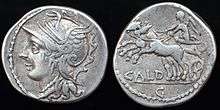Gaius Coelius Caldus
Gaius Coelius Caldus, nomen also spelled Caelius,[1] was a consul of the Roman Republic in 94 BC alongside his colleague Lucius Domitius Ahenobarbus.

 | |
| O: head of Gaius Coelius Caldus, standard inscribed HIS behind and standard in the form of a boar (emblem of Clunia, Hispania) in front C·COEL·CALDVS COS | R: statue of god seated left between two trophies of arms, all on a high lectisternium with front inscribed: L·CALDVS VII·(VIR)·EP(VL), C·CALDVS on left, IMP·(AV)·X on right, C(ALD)VS III VIR below |
| Silver denarius struck by Gaius Coelius Caldus' grandson in Rome 51 BC. Moneyer commemorates his grandfather Gaius Coelius Caldus and other two ancestors: L. Coelius Caldus, Septemvir Epulones and C. Coelius Caldus, Augur, Imperator and member of Decemviri sacris faciundis. | |
In 107 BC, Coelius Caldus was elected tribune of the plebs and passed a lex tabellaria, which ordained that in the courts of justice the votes should be given by means of tables in cases of high treason.[2] Cicero stated that Caldus regretted this law as having been the source of injury to the republic.[3] He was a praetor in 100 or 99 BC, and proconsul of Hispania Citerior the following year.[4] During Sulla's second civil war he tried in conjunction with Gaius Carrinas and Brutus Damasippus to help Gaius Marius the Younger by preventing Pompey from joining his forces to Sulla, but failed.[3]
Coelius' portrait appears on a small series of Roman silver coins from the late republic.[5] Some of his coins feature the boar emblem of Clunia.[6]
See also
References
- These are variants of the same name: William Smith. Dictionary of Greek and Roman Biography and Mythology. Vol. I, p. 532 Archived 2009-11-16 at the Wayback Machine
- William Smith. Dictionary of Greek and Roman Biography and Mythology. Vol. I, p. 561 Archived 2011-06-06 at the Wayback Machine
- Smith, William (1870). Dictionary of Greek and Roman biography and mythology. 1. Boston, Little. p. 561.
- T.R.S. Broughton, The Magistrates of the Roman Republic (American Philological Association, 1952), vol. 2, pp. 1 and 3 (note 2).
- http://www.moneymuseum.com/frontend/coins/periods/coin.jsp?lang=en&i=96767&pid=4529201&gid=51&cid=179&pi=-1&ps=10%5B%5D
- Broughton, MRR2, p. 3.
| Political offices | ||
|---|---|---|
| Preceded by Lucius Licinius Crassus and Quintus Mucius Scaevola Pontifex |
Consul of the Roman Republic with Lucius Domitius Ahenobarbus 94 BC |
Succeeded by Gaius Valerius Flaccus and Marcus Herennius |